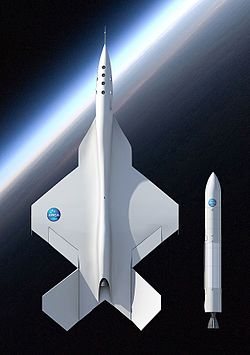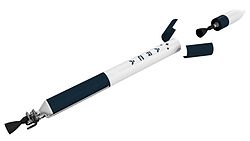Haas (rocket)
This article needs to beupdated.(August 2019) |

Haaswas a family of rocket space launchers developed byARCAspacefor theGoogle Lunar X Prizecompetition and for their national crewed space program. As of 2020[update]no rocket has been launched, the planned rocket types changed significantly over time.
It was named afterConrad Haas,a rocket pioneer who lived and worked in what is now Romania, and was the first European to describe a multistage rocket in writing.[1]
Haas[edit]
Haaswas aRomaniancarrier rocket,which was developed[when?]byARCAas part of theELEprogramme. It was designed to be air-launched from ahigh-altitude balloon,similar to theAmericanRockoonexperiments of the 1950s. Prior to the development of Haas, ARCA had already launched twoStabilorockets from balloons. It was powered byhybrid rocket motor,usinghydrogen peroxideas oxidizer andbitumenas solid fuel.[1]
The Haas rocket[1]was to be a three-stage rocket intended to be capable of placing 400 kilograms of payload intolow Earth orbit.Its maiden flight was to carry theEuropean Lunar Explorerspacecraft, ARCA's entry into theGoogle Lunar X-Prize,following a series of engine tests which began in 2009.[citation needed]
It was abandoned when ARCA decided to stop using solar and helium balloons for their space program.
Haas 2[edit]

Haas 2was an orbital two-stage launcher design intended to be carried under the fuselage of theIAR 111supersonic plane. It was planned to be powered by the newExecutorliquid-fueled rocket engine[2]under development at ARCA. Its intended launch altitude was approximately 17,000 m (56,000 ft). It was intended to place a 400 kg (880 lb) payload into low Earth orbit.[citation needed]
Haas 2CA[edit]


Haas 2CA,previouslyHaas 2c,was a planned flight testing platform for theExecutor engine.It was an intendedsingle-stage-to-orbitvehicle due to its lightweight fuel tanks and was originally planned for a 2018 launch.[3]
General characteristics
- Length:16 m (52 ft 6 in)
- Diameter:1.5 m (4 ft 11 in)
- Max takeoff weight:16,300 kg (35,935 lb)
- Lift-off thrust:22,900 kgf (225 kN; 50,000 lbf)
- Payload toLEO:100 kg (220 lb)
2020 plans[edit]
ARCAspace changed the plans of future rockets over time. As of March 2020, the company plans to develop ground-launchedsingle-stage-to-orbitrockets which can optionally increase their payload with a booster stage (calledLaunch assist system,LAS). It is planned to test two stages of a small orbital rocket (LAS 25RandHaas mini) in independent flights in 2020, before the two are combined for a first orbital flight in 2021. This two-stage rocket is planned to have a payload capacity of 40 kg to low Earth orbit. A larger first stage is expected for 2022, followed by asingle-stage-to-orbitrocketHaas 3in 2023, carrying up to 500 kg of payload. Combining both, ARCAspace expects to achieve a payload capacity of 3 tonnes in 2024. This sequence would repeat with even larger rocket stages, leading to a 60 tonne payload rocket in 2027.[5]

See also[edit]
References[edit]
- ^abcARCA Space,Haas Orbital Rocket LauncherArchived2012-07-22 at theWayback Machinefact sheet, Dec. 2, 2008 (accessed 22 Sept 2014)
- ^ARCA,Executor Rocket EngineArchived2014-10-09 at theWayback Machine(accessed 22 Sept 2014)
- ^ab"ARCA Unveils the World's first Single-Stage-to-Orbit Rocket".2017-03-31.Retrieved2017-03-31.
- ^"Haas 2C specifications page".Archived fromthe originalon 2013-07-17.Retrieved2016-12-29.
- ^"Haas | ARCA".Retrieved7 March2020.
External Pages[edit]
- "Haas Orbital Rocket Launcher"(PDF).ARCA. 2008-12-23. Archived fromthe original(PDF)on 2009-09-20.Retrieved2008-12-25.
- "Romanian Space Program"(PDF).ARCA. 2012-02-25. Archived fromthe original(PDF)on 2014-04-08.Retrieved2012-03-08.
